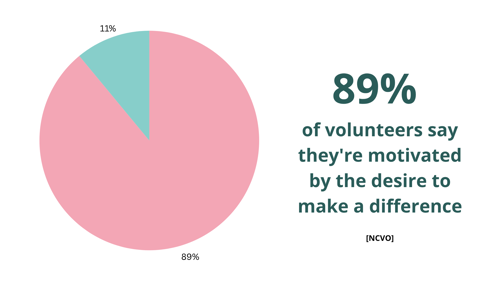The art of staying in touch: how do charities communicate with volunteers today?
From supporting beneficiaries to raising vital funds, volunteers bring time and skills that help keep charities running.
But, when they’re giving their time freely, and can easily drift away if they feel out of touch, keeping them connected and engaged takes thoughtful, consistent communication. To help your charity master the art of staying in touch, this guide explores:
- Why communication is important in volunteering
- How do charities communicate with volunteers successfully?
- How to build a 7-step volunteer communication strategy that really works
Why is communication important in volunteering?
Good communication sits at the heart of every great volunteer experience.
When your volunteers feel informed, valued and listened to, they're far more likely to stay engaged and committed to your cause.

The vast majority of volunteers have a positive experience, with many (89%) saying they volunteer because it makes them feel like they're doing good. Yet, according to the NCVO's Time Well Spent report, around 1 in 5 (19%) of people who hadn't volunteered in the past 12 months said it was because they'd never been asked.
So, why is communication important in volunteering? Because the biggest barrier isn’t often willingness - it’s communication.
Clear and regular communication helps to:
- Reach and retain the volunteers you already have
Staying in touch makes people feel included and appreciated. When volunteers feel connected, they're more likely to stay.
- Build trust
Volunteers want to know their time matters and their efforts have tangible impact.
- Prevent confusion
Clear instructions reduce mistakes and make roles more fulfilling.
- Foster belonging
Being part of a community is often just as important as the task itself.
Communication isn’t just a nice-to-have. It’s what turns goodwill into genuine, lasting relationships.
“Volunteers don’t want to be a name on a list, they want to feel part of something, to know they’re making a difference."
- Katherine Gale, Head of Volunteering, Young Enterprise
How to charities communicate with volunteers successfully?
Firstly, there's no single "right" way to communicate with volunteers. Every charity has its own rhythm and mix of tools. However, the most successful organisations tend to blend personal connection with clever technology.
Here's some of the most common methods:
- Email and newsletters
Great for updates, event invites and sharing impact stories. Just be careful not to overwhelm people - too many emails can lead to inbox fatigue.
- Messaging apps (WhatsApp, Slack, Teams)
Ideal for quick updates and reminders. The downside? It can be tricky to keep track of messages or stay fully GDPR compliant.
- Volunteer portals and apps
Perfect for managing rosters, announcements, and collecting feedback. They work best when everyone’s on board and using them consistently.
- In-person and virtual meetings
Nothing beats real connection for building relationships and training! But they're time-intensive and not always practical for dispersed teams.
- Social media or closed groups
Great for creating a sense of community and sharing stories. Just be mindful not to exclude volunteers who aren’t comfortable using social platforms.
When I looked after volunteers at a small charity, our volunteer communication strategy was largely focused on emails - it was quick and free! But, it wasn't always easy to keep track of who'd seen what or replied.
That's something the team here at Access hear from many charities: as you scale, simple systems can start to creak.
That's why many charities are turning to volunteer management systems - they bring communication, scheduling and recognition into one place. Instead of relying on multiple apps, they allows volunteer managers to send targeted updates, manage rotas, and keep conversations organised without extra admin.
What are the biggest communication challenges for charities?
Even well-resourced charity teams struggle to stay on top of communications at times - and it's never for lack of trying!
Common challenges include:
- Inconsistent messaging: Different departments sending conflicting updates.
- Information overload: Too many emails or channels leaving volunteers unsure what matters most.
- Limited feedback: Volunteers not feeling heard or able to share ideas.
- Manual processes: Staff spending hours chasing confirmations or shift changes.
- Fragmented data: Volunteer contact details stored in spreadsheets, inboxes and sticky notes.
I remember spending an entire Friday afternoon calling around to check who could attend a parenting exhibition to help spread awareness - information that could’ve been captured automatically with better systems.
That’s one of the many reasons having one central hub for volunteer communications, and a clear volunteer communication strategy, makes such a difference.
Case in point: Make-A-Wish UK
Every wish begins with a connection, and that connection often starts with a volunteer.
When Make-A-Wish UK turned to Assemble, they needed a way to better coordinate and communicate with volunteers who help grant life-changing wishes to children with critical illnesses. With hundreds of volunteers spread across the country, consistency was key.
"We were losing volunteers not because they didn’t care, but because the tech was too complicated. Assemble has changed that.”
By using Assemble to make communication and scheduling easier, they've reduced manual admin and strengthened its volunteer community - ensuring everyone received the right information, at the right time, wherever they are.
See how much your charity can save with Access Assemble
How to build an effective volunteer communication strategy
If "why is communication important in volunteering" is the question, a volunteer communication strategy is often the answer.
It's your roadmap for keeping volunteers informed, inspired and involved! It’s more than a contact list or a monthly email - it’s a plan for how your charity listens and responds.
Here’s a simple, 7-step framework:
1. Define your audience
Not all volunteers have the same needs. Segment by role, location and availability. For example, regular event volunteers may prefer real-time app notifications, while long-term supporters may want quarterly updates.
2. Set clear objectives
Are you trying to increase retention, reduce no-shows or boost engagement at events? Clear goals shape your message and tone.
3. Choose the right channels
Use the right tool for each type of message. For example, urgent rota changes might go through an app notification, while impact stories belong in newsletters.
4. Encourage two-way communication
Invite feedback, create suggestion forms and celebrate input! Volunteers are more engaged when they feel heard.
5. Use data to personalise communication
Even small touches, like addressing volunteers by name or referencing past contributions, build connection.
6. Automate where appropriate
Automate reminders, welcome messages, or thank-you notes so volunteers never feel forgotten - while saving your team valuable time.
7. Review and adapt
Gather metrics like message open rates or volunteer survey responses, and refine your approach regularly.
What does great volunteer communication look like in practice?
Going back to "how do charities communicate with volunteers?" ... usually using technology! Though great communication doesn't have to mean big budget tech, because it's primarily about intentionality.
Here's what the best examples have in common:
- Transparency: Volunteers know what’s happening and why.
- Recognition: Simple thank-you messages or shoutouts make a huge difference.
- Community: Charities create spaces (digital or physical) for volunteers to connect.
- Consistency: Everyone receives the same core updates, regardless of role or region.
- Feedback loops: Volunteers have easy ways to share suggestions or concerns.
We see a lot of great examples from Assemble customers, and the biggest wins often come from the simplest gestures. Maybe that's sending a personal thank-you, sharing an update about the difference they'd made, or asking for their thoughts after an event.
Technology helps scale that personal touch, but the heart of it is still human.
“We can share impact stories, key updates, and reminders in one place. It’s helping build that sense of community, especially for people who aren’t physically close to a Mencap office, service or shop.”
- Matt Hatt, Volunteering Services Manager, Mencap
Tools that can help charities communicate better
While people and culture should always come first, the right tools make all the difference. Here's a few categories to consider:
- Volunteer management platforms:
Systems like Access Assemble combine communication, scheduling and reporting, so everything lives in one place.
- Email marketing tools
Great for newsletters and updates (e.g., Dotdigital, Mailchimp)
- Survey and feedback tools
Encourage two-way conversation through forms or polls
- CRM integrations
Connecting your volunteer management software with your charity CRM is always a win. It ensures your volunteer data is secure, current and gives you an overall picture of the support people are giving.
Future trends in volunteer communication
As technology evolves, charities are finding new ways to keep in touch - but the human element remains central.
Emerging trends include:
- AI-powered automation: Tools that send reminders of thank you messages based on volunteer behaviour.
- Personalised engagement: Communications tailored by role, interest or location.
- Mobile-first design: Volunteers increasingly expect updates via mobile apps.
- Integrated ecosystems: Platforms like Assemble can form part of an entire charity software suite that pulls all the data you need from across your organisation, into one place.
Explore the Access Charity Software Suite
Round up: Clear communication builds stronger communities
When volunteers feel valued, informed and connected, they give their best - and your charity achieves more.
The art of staying in touch isn’t about constant messaging; it’s about meaningful, consistent communication that helps everyone feel part of the mission.
If you’re reviewing how your charity communicates with volunteers, start small: ask for feedback, review your channels, and look for one process you can simplify this month.
And if you’d like to see how technology can support that journey, take a look at Access Assemble, the volunteer management platform helping charities like Make-A-Wish UK improve communication and strengthen connections.
REFERENCES
1. National Council for Voluntary Organisations (NCVO) – Time Well Spent Report.

 AU & NZ
AU & NZ
 SG
SG
 MY
MY
 US
US
 IE
IE



